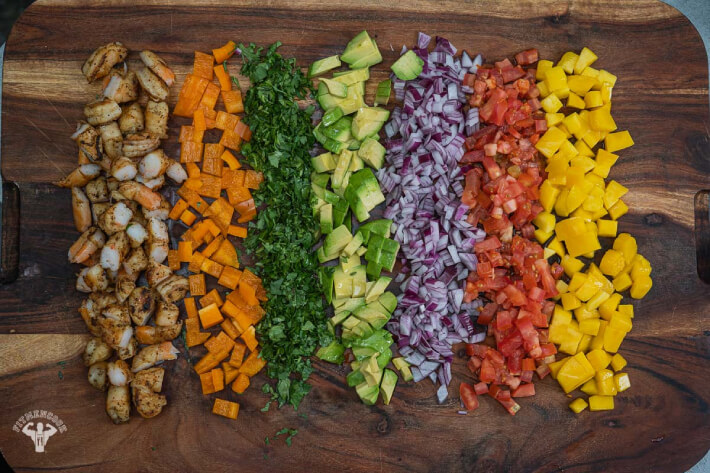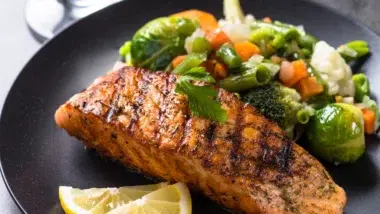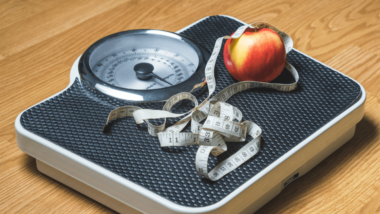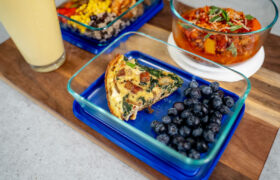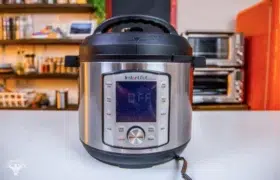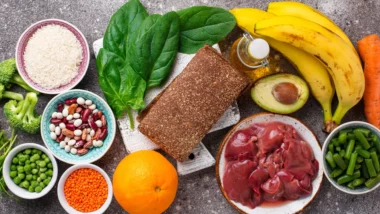Are you feeling overwhelmed by the idea of meal prep? Trust me, I know how you feel. But don’t worry, I’ve got your back!
As someone who has struggled with maintaining a healthy diet in the past, I’ve discovered that meal prep is the key to success. And the first step to successful, healthy meal prep is creating a grocery list.
That’s why I’m here to help you create an easy meal prep grocery list that will make your life so much easier. No more wandering aimlessly through the aisles, unsure of what to buy.
We’ll start in the produce section and choose the freshest fruits and veggies that will keep you feeling energized and full throughout the day.
Next, we’ll head to the center aisles to stock up on all the necessary grains, spices, and sauces that will add flavor and variety to your meals.
And finally, we’ll grab some protein and refrigerator items, making sure to save the coldest items for the end of our shopping run so they stay fresh until you can get to the kitchen.
But let’s not forget the most important part of meal prep – the food! I’ll be sharing some of my favorite recipes for meal prepping that are not only delicious but also packed with the nutrients your body needs.
So, don’t let the idea of meal prep overwhelm you any longer. With a meal prep plan and a little bit of preparation, you’ll be well on your way to a healthier, happier you!
Getting Started with Your Healthy Meal Prep Grocery List
Before we hit the grocery store, here are a few tips to keep in mind to help reduce stress, save money, and stock your kitchen with all of the ingredients you’ll need.
Tips for a Cheap Meal Prep Grocery List
- Plan your meals ahead of time: Before you go grocery shopping, decide what meals you want to cook for the week. This will help you make a good list and find everything you need at the store.
- Choose a designated day for grocery shopping: Pick a day of the week to do your grocery shopping. This will help you remember to do it every week, and it will make meal prep a regular part of your routine.
- Check your pantry and fridge before you go: Take a look at what you already have at home before you go to the store. This will help you avoid buying things you already have and save you money.
- Write out your grocery lists: Make a list of everything you need before you go to the store. Meal prep with a grocery list in hand will help you remember what you need and make your trip quicker and easier.
- Buy in bulk: Buying big bags of things like rice, beans, and nuts can save you money in the long run. Look for things that you use a lot and buy them in big bags.
- Look for sales and discounts: Keep an eye out for deals on things you buy a lot or things that are in season. This can help you save money and try new things.
- Choose a variety of ingredients: Try to buy things that you can use in more than one meal. This will help you make the most of what you buy and save you money.
- Don’t forget about snacks: Get some healthy snacks like fruit, veggies, and nuts to eat between meals. This will help you stay full and have energy throughout the day.
- Invest in quality storage containers: Get some good containers to keep your meals in, like glass containers and stainless steel containers. This will make it easier to store them in the fridge or freezer and reheat them later.
With these tips, you’ll be set for a successful meal prep and grocery list!
Tips for Kitchen Tools on Your Grocery List for Healthy Meal Prep
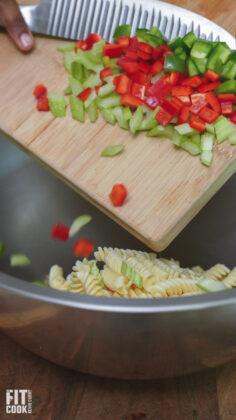
When it comes to meal prepping, having the right kitchen tools can make all the difference. From sharp knives to sturdy cutting boards, these essentials can save you time and frustration in the kitchen. If you’re just starting out, don’t worry about buying everything at once. You can slowly build up your collection of cooking tools by adding one quality item to your grocery list each week.
Here are some kitchen tools to consider adding to your weekly meal prep grocery list:
- A sharp chef’s knife
- Cutting boards (plastic or wood)
- Measuring cups and spoons
- Mixing bowls
- Vegetable peeler
- Sheet pan and oven-safe dishes
- Tongs or spatulas
- Muffin tins
Investing in higher-priced tools can make meal prep even more efficient. Consider adding these tools to your collection when you’re ready to take your meal prep game to the next level:
- Food processor
- High-quality blender
- Instant Pot or pressure cooker
- Air Fryer
- Cast iron skillet
- Kitchen scale
When choosing your kitchen tools, look for items that are durable, easy to clean, and fit your cooking needs. With these essentials on hand, you’ll be well on your way to making delicious and healthy meals in no time!
Creating the PERFECT Weekly Meal Prep and Grocery List
Are you ready to start meal prepping like a pro? Planning ahead and creating a grocery list is a crucial first step. So, let’s dive into a list of individual grocery items that can help make meal prep easier and more efficient.
Keep in mind that not all of these items may fit your personal dietary needs or preferences, so it’s important to choose the ones that work for you. And the quantity of each item should be based on your meal plan and the number of people you’re cooking for. Take some time to review the list and select the items that fit your specific needs to create the perfect grocery list for your meal prep routine.
Choose Your Produce
A well-stocked produce list is a must-have! Here are some recommended items to add to your grocery list. When it comes to meal prep, choosing the right produce is crucial for making the process efficient, cost-effective, and enjoyable. It’s important to select items that are versatile, long-lasting, and easy to prepare. Also, buying a variety of fruits and vegetables gives you a balanced and nutritious diet. This list provides a range of options with descriptions and benefits to help you choose which produce will work best for your meal prep needs.
- Apples: Rich in fiber and vitamin C, and may help lower the risk of heart disease and improve digestion.
- Avocados: A great source of healthy fats and fiber, and perfect for topping salads or using in guacamole.
- Bananas: High in potassium, which can help regulate blood pressure and is a good source of fiber and vitamin C.
- Bell Peppers: Prep and keep well in the fridge, and can be used in a variety of dishes, from stir-fry to salads to fajitas.
- Blueberries: Packed with antioxidants and vitamin C, and may help improve brain function and protect against chronic diseases.
- Broccoli: High in vitamins and fiber, and easy to prepare with a quick steam or oven roast.
- Brussels sprouts: Another nutritious and delicious veggie that can be roasted or sautéed for a flavorful side dish.
- Carrots: Can be eaten raw or cooked, and are a good source of vitamins and minerals.
- Cucumbers: Refreshing and low in calories, they make a great addition to salads or as a snack on their own.
- Grapes: Contain antioxidants and may help protect against certain types of cancer and improve heart health.
- Green Beans: A versatile and tasty veggie that can be sautéed, steamed, or roasted.
- Green Onions: A flavorful addition to many dishes, including salads, stir-fries, and soups.
- Herbs (cilantro, basil, mint, parsley): Fresh herbs add a burst of flavor to any dish and are a great source of antioxidants.
- Kale: A budget-friendly meal prep green that holds up well in the fridge even when pre-dressed, and can be eaten raw or sautéed.
- Kiwi: A good source of vitamin C and fiber, and may help improve digestion and boost the immune system.
- Leeks: A flavorful member of the onion family that can be used in soups, stews, and other dishes.
- Lettuces (butter, bibb, romaine, arugula, cabbage, etc.): A staple for salads, wraps, and lettuce cups, and available in a variety of types for different tastes.
- Mango: Rich in vitamin C, vitamin A, and antioxidants, and may help improve skin health and boost immune function.
- Onions: Used in a variety of recipes and can be stored for a long time in a cool, dark place.
- Oranges: High in vitamin C and other antioxidants, and may help reduce the risk of chronic diseases and improve heart health.
- Peppers (bell, jalapeños, or serranos): Versatile and flavorful, and great for adding a kick to any dish.
- Pineapple: Contains digestive enzymes that may help improve digestion, and a good source of vitamin C and antioxidants.
- Pre-shredded slaw: Convenient and easy to use, and won’t wilt in the fridge.
- Radishes: A crunchy and refreshing addition to salads and tacos, and a good source of vitamin C.
- Spinach: A nutrient-dense green that can be eaten raw or sautéed, and a great addition to smoothies.
- Strawberries: Packed with vitamin C and antioxidants, and may help improve heart health and reduce inflammation.
- Squash and Zucchini: Can be grilled, sautéed, or roasted, and a good source of vitamins and minerals.
- Sweet Potatoes: Can be eaten for breakfast, as a side dish, or in a variety of dishes, and a good source of fiber and vitamins.
- Tomatoes: A versatile and flavorful ingredient that can be used in a variety of dishes, including salads, soups, and pasta sauces.
- Watermelon: High in water content and a good source of vitamin C, and may help improve hydration and lower the risk of chronic diseases.
Remember, fresh produce is key for salads, wraps, and grain bowl toppings, while pre-cut and bagged veggies are convenient for quick meals.
Add Pantry Staples
Pantry items are a staple in any kitchen, and having a well-stocked pantry can make meal planning and preparation a breeze. Here are some grocery options to consider for your pantry:
Grains:
- Quinoa: A great source of protein and fiber.
- Brown rice: A nutritious whole grain that is easy to cook.
- Farro: A versatile grain that can be used in salads, soups, or as a side dish.
- Oats: A heart-healthy whole grain that can be used in baking or as a breakfast cereal.
Seeds and Nuts:
- Chia: A good source of omega-3 fatty acids and fiber.
- Almonds, cashews, etc.: A healthy snack or a crunchy addition to salads, stir-fries, and baked goods.
Oils and Broth:
- Olive oil: A healthy oil that can be used in cooking or as a salad dressing.
- Broth (chicken or vegetable): A flavorful base for soups, stews, and sauces.
Spices:
- Turmeric powder: A spice with anti-inflammatory properties that can be used in a variety of dishes.
- Ground coriander: A versatile spice that can be used in curries, soups, and marinades.
- Five spice powder: A blend of spices commonly used in Chinese cuisine.
- Other: Any other spices you prefer for particular cuisine.
International Flavors:
- Tahini: A paste made from ground sesame seeds, commonly used in Middle Eastern cuisine for sauces, dips, and dressings.
- Hoisin sauce: A sweet and savory sauce commonly used in Chinese cuisine.
- Soy sauce: A salty condiment used in many Asian dishes.
- Pesto: A classic Italian sauce made from basil, pine nuts, garlic, and Parmesan cheese. It’s great for adding flavor to pasta, sandwiches, or roasted vegetables.
- Rice vinegar: A mild vinegar used in many Asian dishes.
- Sambal Oelek (or other chile pastes): A spicy condiment commonly used in Southeast Asian cuisine.
- Toasted sesame oil: A flavorful oil used in many Asian dishes.
- Water chestnuts, bamboo shoots: Crunchy and mild-flavored vegetables commonly used in Chinese cuisine.
- Chimichurri sauce: A South American sauce made from parsley, garlic, vinegar, and oil. It’s often used as a marinade or sauce for grilled meats.
- Sriracha: A spicy sauce made from chili peppers, vinegar, garlic, and sugar. It’s commonly used as a condiment for Vietnamese or Thai dishes.
Protein powder (whey, soy, or plant-based): A convenient source of protein to add to smoothies or baked goods for a protein boost.
Remember to check your pantry before heading to the store, and fill in the blanks with the items you need to make your favorite dishes. With a well-stocked pantry, you’ll be able to whip up delicious and nutritious meals in no time!
Stock the Fridge
When it comes to meal prep, it’s not just about the fresh produce you choose. You also need to consider the proteins and dairy products you’ll be using to round out your meals. From chicken to tofu, cheese to yogurt, here are some essential fridge staples to add to your grocery list.
Proteins:
- Chicken breast
- Chicken thighs
- Ground turkey
- Lean ground beef
- Bacon
- Rotisserie chicken
- Shrimp
- Fish (think salmon, tuna, mackerel)
- Tofu
- Meat replacements, like Boca patties
Dairy:
- Eggs
- Liquid egg whites
- Cottage cheese
- Greek or Icelandic yogurt, or coconut yogurt
- Milk or plant-based milk
Snacks:
- Protein bars
- Hummus
Keep in Mind:
- Look for lean protein sources to minimize fat content
- Consider plant-based options for protein (tofu, beans, lentils) to vary your sources
- Choose Greek or Icelandic yogurt for higher protein content
- Opt for unsweetened plant-based milks to minimize added sugars.
Think About Storage
When it comes to meal prep, having quality food containers is essential. They help you organize and store your meals efficiently, and make it easy to bring them along wherever you go. But with so many options available, it can be overwhelming to decide which containers to buy.
The good news is that investing in quality meal prep containers is worth it in the long run. Not only do they save you money by reducing waste, but they also keep your food fresh for longer and make it easier to stick to your meal plan. Plus, having a variety of container sizes and shapes ensures that you can portion out your meals correctly, and you can choose containers that suit your individual needs, whether that’s portion control, leak-proof options, or microwave-safe materials.
When adding meal prep containers to your grocery list, there are a few things to keep in mind:
- Consider the material the container is made of. Glass containers are durable, easy to clean, and won’t absorb odors or stains, while plastic containers are lightweight and often come with snap-on lids for easy transport.
- Make sure to choose containers that fit your needs. Purchase containers that are freezer-safe if you plan on freezing your meals, and microwave-safe if you plan on reheating them.
- Consider the size and shape. Think of your typical menu and purchase containers based on the types of meals you’ll be prepping.
Overall, investing in quality meal prep containers is a smart choice that will make your meal prep routine easier and more enjoyable. Plus, having the right containers on hand means you can spend less time worrying about storage and more time enjoying your delicious and healthy meals.
Now That You Weekly Meal Prep Grocery List. Let’s Get Cooking!
Here are some recipes to get you started:
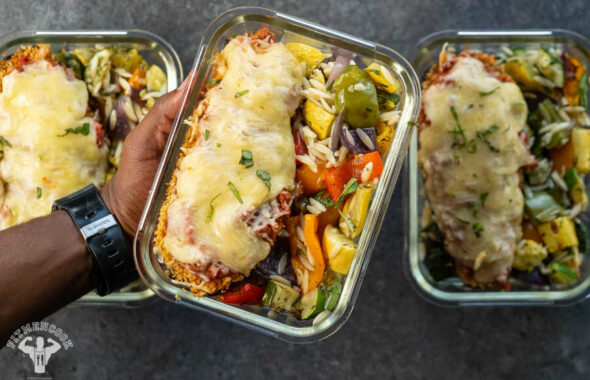
Easy Eggplant Parmesan Recipe & Orzo Veggie Medley Meal Prep
Pecan Spiced Granola Meal Prep
Low-Carb Coconut Curry Slow Cooker Meal Prep
Vegan BBQ Beans With Tahini Sauce – Vegan Meal Prep
Savory Roasted Vegetables For Meal Prep
Spiced Chicken Thigh Meal Prep
Sesame Beef Broccoli Meal Prep Recipe
Chicken & Broccoli Casserole Meal Prep In Jars
Bison Roast & Mashed Parsnips – Paleo Prep
Now that you know all about the benefits of meal prepping and some easy-to-make recipes, it’s time to put your knowledge into action. Don’t be afraid to get creative with your meals, and remember that meal prepping doesn’t have to be boring or repetitive.
When you’re planning your meals, think about what you like to eat and what ingredients are in season. Incorporate different fruits, vegetables, and proteins to keep things interesting. Don’t forget to use spices and seasonings to add flavor without adding extra calories.
One of the best things about meal prepping is that it saves you time and money in the long run. By planning and preparing your meals ahead of time, you’ll be less likely to eat out or order takeout, which can be costly and unhealthy. Plus, you’ll have more time during the week to focus on other things you enjoy.
So, whether you’re a busy professional, a student, or just looking to eat healthier, meal prepping is a great option to consider. Give it a try and see how it can make your life easier and your meals more delicious!
